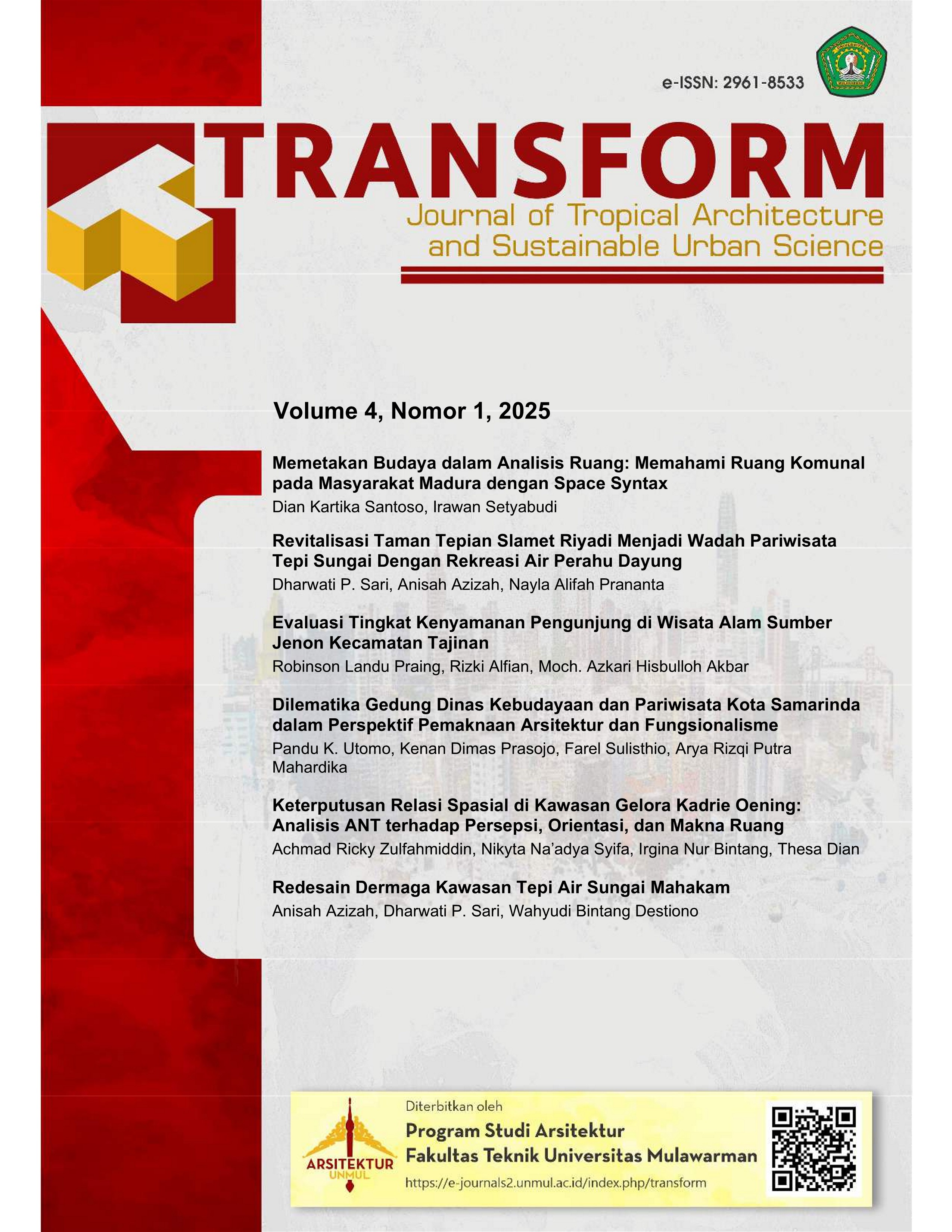Keterputusan Relasi Spasial di Kawasan Gelora Kadrie Oening: Analisis ANT terhadap Persepsi, Orientasi, dan Makna Ruang
DOI:
https://doi.org/10.30872/transform.v4i1.3500Keywords:
Actor-Network Theory, Gelora Kadrie Oening, sense of place, teori kenyamanan, spatial recognitionAbstract
The Gelora Kadrie Oening (GOR Sempaja) area in Samarinda is a public space with a density of sports activities, performances, and social interactions. However, in the dynamics of the space, there is a disconnection of spatial relations between users, managers, and spatial elements such as Aji Muhammad Salehuddin II Hospital, access patterns from the main door, and post-sports consumption spaces. This research uses the Actor-Network Theory (ANT) approach to understand the connectedness and disconnectedness of human and non-human actors in the spatial structure of the area. Three main phenomena were identified: the unrecognized presence of RSUD, the shift of access from the front gate to the side lane, and the post-physical activity snacking pattern. All three were analyzed within the framework of architectural theory; sense of place, comfort theory, and spatial recognition. The findings indicate a rift in the system of perception, orientation, and spatial meaning, which hinders the overall integration of the area.
References
Brewer, Graham, Aiobheann McVeigh, and Jason von Meding. 2013. “An Evaluation of the Usefulness of Actor Network Theory in Understanding the Complexities of Vulnerability and Resilience in Post-Disaster Reconstruction.” Archnet-IJAR 7(3): 80–92. doi:10.26687/archnet-ijar.v7i3.50.
Farías, Ignacio. 2011. “The Politics of Urban Assemblages.” City 15(3–4): 365–74. doi:10.1080/13604813.2011.595110.
Hatta, Asta Juliarman, and Agus S. Ekomadyo. 2020. “Relasi Jejaring Aktor Masyarakat Suku Bugis Soppeng Dalam Tradisi Mendirikan Rumah (Mappatettong Bola).” Jurnal Arsitektur ARCADE 4(3): 292. doi:10.31848/arcade.v4i3.426.
Latour, Bruno. 2005. Reassembling the Social: An Introduction to Actor-Network-Theory (Clarendon Lectures in Management Studies).
Sachari, Agus, Frans Prasetyo, and Sonny Yuliar. 2013. “Place Construction and Urban Social Transformation : An Actor Network Theory Analysis for Creative-Kampung Phenomena in Bandung.” Habitecno International Seminar (May 2016): 230–39.
Sugiarto, Daris, and Ady R Thahir. 2018. “Hubungan Tata Letak Ruang Terbuka Publik Terhadap Efektifitas Pemanfaatannya.” Jurnal Lingkungan Binaan Indonesia 7(3): 154–60. doi:10.32315/jlbi.7.3.154.
Tamariska, Stirena Rossy, and Agus S. Ekomadyo. 2017. “‘Place-Making’ Ruang Interaksi Sosial Kampung Kota’.” Jurnal Koridor 8(2): 172–83. doi:10.32734/koridor.v8i2.1345.
Vroman, Liselotte, and Thierry Lagrange. 2017. “Human Movement in Public Spaces: The Use and Development of Motion-Oriented Design Strategies.” Design Journal 20(sup1): S3252–61. doi:10.1080/14606925.2017.1352830.
Yao, Song, and Kui Liu. 2022. “Actor-Network Theory: Insights into the Study of Social-Ecological Resilience.” International Journal of Environmental Research and Public Health 19(24). doi:10.3390/ijerph192416704.
Downloads
Published
Issue
Section
License
Copyright (c) 2025 TRANSFORM: Journal of Tropical Architecture and Sustainable Urban Science

This work is licensed under a Creative Commons Attribution-ShareAlike 4.0 International License.












